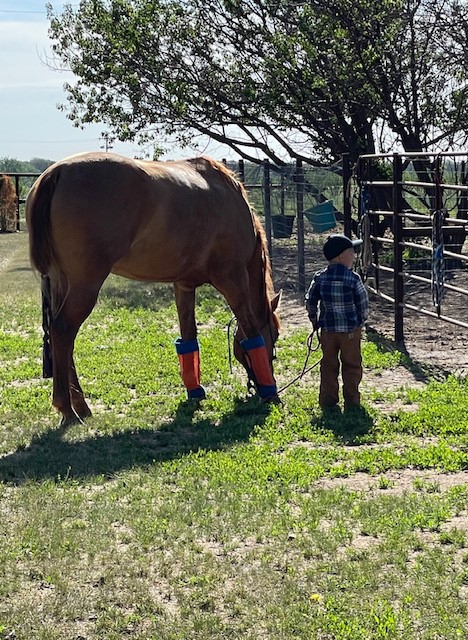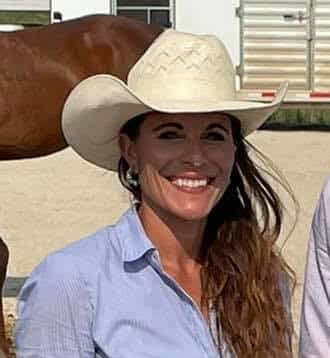Balance Your Feed Program

Feed for Thought [Photo: submitted]
Coming into a northern winter, horse owners have high anticipation when it comes to feeding and nurturing their animals the best way possible.
Steven Hepper, Grain Merchandiser, Bismarck, of Hubbard Feed-Ridley USA INC., said that when addressing the upcoming season and feeding our horses, a great thing to look at is a mineral program.
“A lot of our customers test hay for quality and their water as well. Based on those factors, a feed program fitting your herd can be built from there,” noted Hepper.
Dr. Edward Bonnette, PHD Nutritionist for Hubbard Feeds, Ohio, pointed out that there are two parts to feeding a horse. The forage program and the feeds/grains to adjust to the forage.
A key point that Bonnette confirmed about horses is that they are ‘highly adaptable.’ “The management of your horses and their feed program depends a lot on how things look in the big picture and that big picture is to keep everything in balance,” said Bonnette.
High alfalfa feeds have a high amount of calcium. We have to look at the type of forage and the quality to determine what type of minerals need to be fed.
“In the winter time, horses release fat soluble vitamins and cells whereas, in the summertime, the green grass hosts fat soluble vitamins such as A, D, E and K. These vitamins are stored in fat cells. The greener the hay and forage, the more vitamins are in it,” noted Bonnette.
If there is a variability in the forage you’re getting, Bonnette advises to go ahead and add vitamins and minerals that your horses may be lacking. “Some hay is just drier and lighter than others, we can’t always control that. We aim for the highest quality, but variance in forage is common,” said Bonnette.
“Horses that are stressed, lactating and getting worked really hard or being hauled, may need some B-complex vitamins. B vitamins are absorbed in the hind gut of a horse. When they are stressed, the hind gut is usually the place where you should have concern,” Bonnette advised. “Senior horses hind guts also don’t absorb these B-vitamins very well, along with vitamin C, so adding these may really benefit the health of your aged horses too.”
Loose mineral usually has everything in balance from mineral to salt ratios. “I like to look at loose minerals as a ‘cheap insurance’ when it comes to a feed program,” noted Bonnette.
Bonnette advises against white salt blocks for the most part. “The thing about minerals is that they don’t really taste as good as salt, so what is the horse going to choose if something good is in front of them or something like the minerals—what they need—in front of them? They are going to go for the salt block, so just take the temptation away,” added Bonnette.
Getting rid of the white salt block and feeding a loose mineral on top of your grain or having it available to your herd is something you can physically keep an eye on and pay attention to. A horse owner can determine which horses are consuming them. “Sometimes people have lick tubs or blocks in the pen and don’t realize that one horse is consuming all of it. Top dressing a feed daily, for each animal, is another form of management that is a positive for horse and owner,” said the PHD nutritionist.
Bonnette pointed out that there is no one way of feeding that is perfect, and there are a lot of successful feed management programs. Horses will adapt in a managed feed program. Over time, better nutrition in feeds have become accessible due to technology.
“New technology has allowed us to put a fat molecule around the mineral to protect it. This helps the absorption rate in the animal and also longevity of the packaged feeds,” Bonnette said.
Local feed manufacturers such as Hubbard Feeds in Bismarck offer a variety of grains, fortified feeds, minerals and vitamins—available in many forms. To keep on top of your feeding program, Bonnette reminds horse owners to look at the labels, do your research, and keep in mind that the big picture is keeping everything in balance when it comes to the health of your horses.

Tisa Peek is a long-time horse trainer, competitor in barrel racing and team roping, and writer about the equine. Rodeo and horses run deep in her roots. JT Family Equine is where she calls home, south of Bismarck, ND. Tisa, along with her husband, Jon, and boys, Blu and River, train horses and host clinics. Tisa is the host for Dakota Cowboy on BEK TV.
